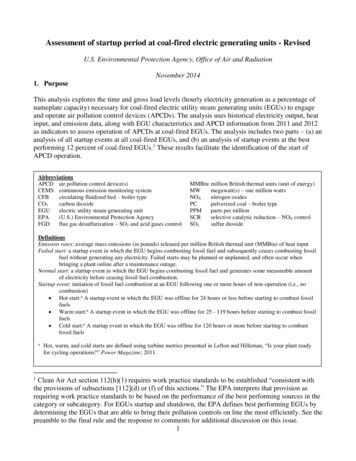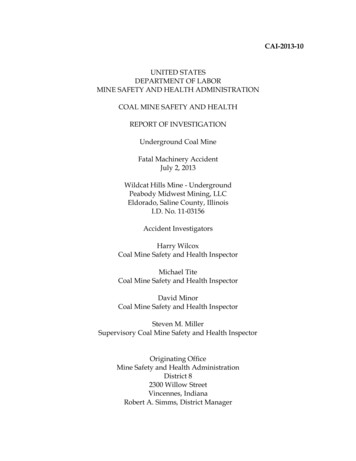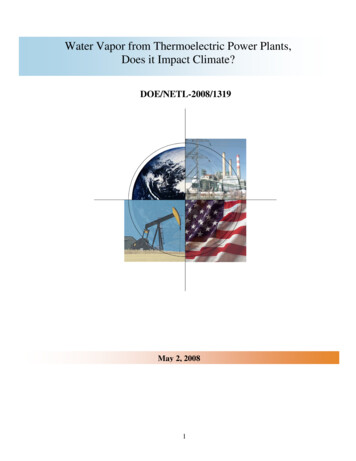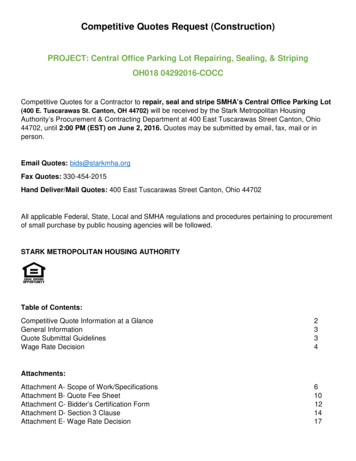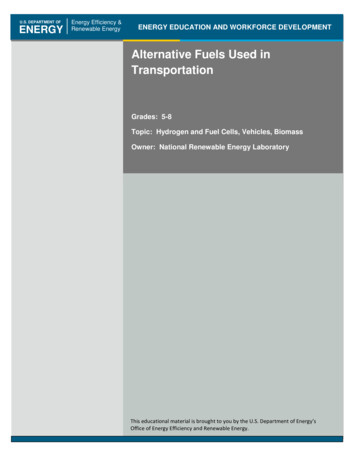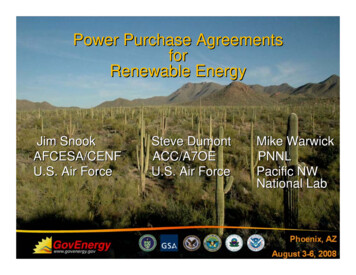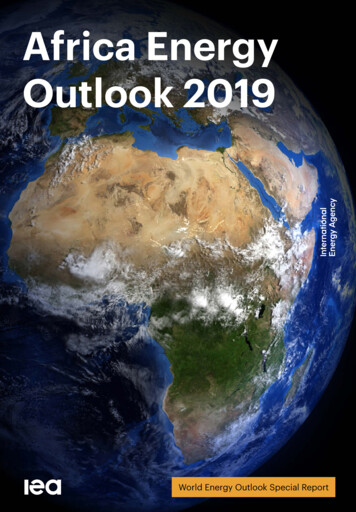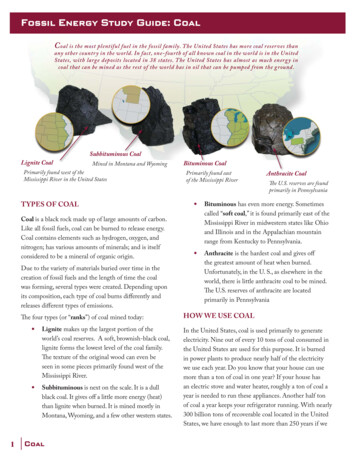
Transcription
Fossil Energy Study Guide: CoalC oal is the most plentiful fuel in the fossil family. The United States has more coal reserves thanany other country in the world. In fact, one-fourth of all known coal in the world is in the UnitedStates, with large deposits located in 38 states. The United States has almost as much energ y incoal that can be mined as the rest of the world has in oil that can be pumped from the ground.Subbituminous CSCoallLignite CoalMined in Montana and WyomingPrimarily found west of theMississippi River in the United StatesTYPES OF COALCoal is a black rock made up of large amounts of carbon.Like all fossil fuels, coal can be burned to release energy.Coal contains elements such as hydrogen, oxygen, andnitrogen; has various amounts of minerals; and is itselfconsidered to be a mineral of organic origin.Due to the variety of materials buried over time in thecreation of fossil fuels and the length of time the coalwas forming, several types were created. Depending uponits composition, each type of coal burns differently andreleases different types of emissions.The four types (or “ranks”) of coal mined today:1 Lignite makes up the largest portion of theworld’s coal reserves. A soft, brownish-black coal,lignite forms the lowest level of the coal family.The texture of the original wood can even beseen in some pieces primarily found west of theMississippi River. Subbituminous is next on the scale. It is a dullblack coal. It gives off a little more energy (heat)than lignite when burned. It is mined mostly inMontana, Wyoming, and a few other western states.CoalBituminousiCoalPrimarily found eastof the Mississippi RiverAnthracite CoalThe U.S. reserves are foundprimarily in Pennsylvania Bituminous has even more energy. Sometimescalled “soft coal,” it is found primarily east of theMississippi River in midwestern states like Ohioand Illinois and in the Appalachian mountainrange from Kentucky to Pennsylvania. Anthracite is the hardest coal and gives offthe greatest amount of heat when burned.Unfortunately, in the U. S., as elsewhere in theworld, there is little anthracite coal to be mined.The U.S. reserves of anthracite are locatedprimarily in PennsylvaniaHOW WE USE COALIn the United States, coal is used primarily to generateelectricity. Nine out of every 10 tons of coal consumed inthe United States are used for this purpose. It is burnedin power plants to produce nearly half of the electricitywe use each year. Do you know that your house can usemore than a ton of coal in one year? If your house hasan electric stove and water heater, roughly a ton of coal ayear is needed to run these appliances. Another half tonof coal a year keeps your refrigerator running. With nearly300 billion tons of recoverable coal located in the UnitedStates, we have enough to last more than 250 years if we
Fossil Energy Study Guide: Coalcontinue to use coal at the same rate as we use it today.Coal is also used in the industrial and manufacturingindustries. The steel industry, for example, uses largeamounts of coal. The coal is baked in hot furnaces to makecoke, which is used to smelt iron ore into the iron neededfor making steel. The very high temperatures created fromthe use of coke gives steel the strength and flexibilityneeded for making bridges, buildings, and automobiles.Coal’s heat and by-products are also used to make avariety of products. For example, methanol and ethylene—ingredients in coal that can be separated out—can beused to make plastics, tar, synthetic fibers, fertilizers, andmedicines.In the United States,coal burned in power plants produces nearly half of the electricity weuse each year.The United States exports about 5 percent of the coalmined in the country. In 2008, 59.1 million short tons ofcoal were exported to other countries, including Canada,Brazil, and Italy. More than half of the coal exports areused for making steel.HOW WE MINE COALIn the United States, coal is currently mined in 25 states,primarily by using either surface mining techniques orunderground methods.Surface mining accounts for about 60 percent of the coalproduced in the United States. It is used mostly in theWest where huge coal deposits lie near the surface and canbe up to 100 feet thick.In surface mining, bulldozers clear and level the miningarea. Topsoil is removed and stored for later use in theland reclamation process. Specially designed machines—draglines, or large shovels—clear away the overburden(material overlaying coal that must be removed beforemining can commence) to expose the coal bed. Smallershovels load the coal into large trucks that remove the coalfrom the pit.The very high temperatures,made possible by the use of coke (coal baked in hot furnaces), give steelthe strength and flexibility needed for making bridges, buildings, andautomobiles.2CoalBefore mining begins, coal companies must post bondsfor each acre of land to be mined to assure that it willbe properly reclaimed. In the reclamation process, first
Fossil Energy Study Guide: Coalthe overburden, then the soils are replaced and the arearestored as nearly as possible to its original contours. Since1977, more than 2 million acres of coal mine lands havebeen reclaimed in this manner.Where coal seams are too deep or the land is too hilly forsurface mining, coal miners must go underground to extractthe coal. Most underground mining takes place east of theMississippi, especially in the Appalachian mountain statesand is used to produce about 30 percent of U.S. coal today.The type of underground mine technique used isdetermined by how the coal seam is situated. If a coaloutcrop appears at the surface of a hillside, a “drift mine”can be driven horizontally into the seam. Where the bed ofcoal is close to the surface, yet too deep for surface mining, aslope mine can be constructed with the mine shaft slantingdownward from the surface to the coal seam. To reachdeeper seams, which may be as much as 2,000 feet below thesurface, vertical shafts are cut through the overburden.Underground mining today is highly mechanized. Theprincipal methods of production are machines calledRocklick Coal Mine, West VirginiaShot of a coal yard showing conveyor belts3Coal“longwall miners” and “continuous miners.” In longwallmining, a cutter moves under a long panel of hydraulic roofsupports which protect the coal miners and move forwardas work progresses. As the coal is cut from the seam, itfalls onto a conveyor belt that removes it from the mine.Longwall mining accounts for more than half of the coalproduced underground.Continuous mining is associated with another commonmethod of extracting coal from underground, the “room-andpillar” method. A continuous mining machine breaks coalfrom the face of the seam with tungsten bits on a revolvingcylinder then moves the coal onto a conveyor belt fortransport to the surface. After advancing a specified distance,the continuous miner is backed out and roof bolts are driveninto the ceiling of the mined area to bind several layersof strata into a layer strong enough to support its weight.In a “room-and-pillar” mine, coal is extracted in carefullyengineered patterns, leaving large columns of coal behind tohelp support the roof. As much as half the coal remains in themine in the form of these pillars.
Fossil Energy Study Guide: CoalHISTORY OF COAL4CoalTODAYCoal is used to generate nearly half of theelectricity used in the United States.1900SBy 1910, coal accounts for more than three-quartersof the total energy used in the United States, butis later supplanted by oil and natural gas fortransportation and residential applications. Itre-emerges later as an affordable, abundantdomestic energy resource to support the growingdemand for electricity.1800SJames Watt invents the steam engine and uses coalto make the steam to run the engine.The Industrial Revolution spreads to the U.S. assteamships and steam-powered railroads becomethe main forms of transportation, using coal tofuel their broilers.Late 1800s: During the Civil War, weapons factoriesbegin using coal. By 1875, coke replaces charcoal asthe primary fuel for iron blast furnaces to make steel.1880s: Coal is first used to generate electricity forhomes and factories.1700SThe English find coal produces a fuel that burnscleaner and hotter than wood charcoal.1740s: Commercial coal mines begin operationin Virginia.1673Explorers to the United States discover coal.1300SIn the U.S. southwest, Hopi Indians use coal forheating.100 – 200 ADThe Romans use coal for heating.STONE AGEIt is believed coal was used for heating and cooking.
Fossil Energy Study Guide: CoalCOAL AND THEENVIRONMENTWhile we may rely on coal for nearlyhalf of our electricity, it is far from beingthe perfect fuel. Coal contains traces ofimpurities like sulfur and nitrogen. Whencoal burns, these impurities are releasedinto the air, where they can combine withwater vapor (for example, in clouds) andform droplets that fall to earth as weakforms of sulfuric and nitric acid—called“acid rain.” There are also tiny specks ofTampa Electric’s Polk Power Stationminerals—including common dirt—mixedOne of the most advanced—and cleanest—coal power plants in the world.in coal. These particles don’t burn and makeup the ash left behind in a coal combustor.Some of the particles also get caught up in the swirlingTWO CURRENT CLEAN COALTECHNOLOGIEScombustion gases and, along with water vapor, formthe smoke that comes out of a coal plant’s smokestack.COAL GASIFICATIONMercury is another potentially harmful emission containedin coal power plant emissions.One of the most advanced—and cleanest—coal powerAlso, coal, like all fossil fuels, is formed out of carbon. Allplants in the world is Tampa Electric’s Polk Power Stationliving things—even people—are made up of carbon. Butin Florida. Rather than burning coal, it turns coal into a gaswhen coal burns, its carbon combines with oxygen in thethat can be cleaned of almost all pollutants.air and forms carbon dioxide. Carbon dioxide (CO2) is aCoal gasification offers one of the most versatile and cleancolorless, odorless gas, but in the atmosphere, it is one ofways to convert coal into electricity, hydrogen, and otherseveral gases that can trap the earth’s heat. Many scientistsvaluable energy products. Gasification, in fact, may be onebelieve this is causing the earth’s temperature to rise, andof the best ways to produce clean-burning hydrogen forthis warming could be altering the earth’s climate.tomorrow’s automobiles and power-generating fuel cells.While coal used to be a dirty fuel to burn, technologyHydrogen and other coal gases can also be used to fueladvances have helped to greatly improve air quality,power-generating turbines, or as the chemical “buildingespecially in the last 20 years. Scientists have developedblocks” for a wide range of commercial products.ways to capture the pollutants trapped in coal before theyGasification breaks down coal into its basic elements. Toescape into the atmosphere. Today, technology can filterdo this, the coal is exposed to hot steam and air or oxygenout 99 percent of the tiny particles and remove more thanunder high temperatures and pressures. This causes the95 percent of the acid rain pollutants in coal, and alsocarbon molecules to break apart, creating a chemical reactionhelp control mercury. We also have new technologies thatthat will typically produce a mixture of carbon monoxide,limit the release of carbon dioxide by burning coal morehydrogen, and other gaseous compounds, forming what isefficiently. Many of these technologies belong to a familycommonly referred to as syngas.of energy systems called “clean coal technologies.”5Coal
Fossil Energy Study Guide: CoalCREATING ELECTRICITY WITH COAL GASIFICATIONIntegrated Gasification Combined Cycle1. Coal, water, and oxygen are fed into a high-pressure gasifier,7. The syngas can either be burned in a combustion turbinewhere the coal is partially combusted and converted intosynthetic gas (“syngas”).or used as a feedback for other marketable chemical products.2. The ash in the coal is converted to inert, glassy slag.3. The syngas produced in the gasifier is cooled and cleaned ofelectricity.particles.Recovery Steam Generator (HRSG).4. The slag and other inert material may be used to produce10. Steam produced in the HRSG, along with additionalother products or may be safely managed in a landfill.5. Next, the syngas passes through a bed of activated charcoal,steam that has been generated throughout the process, drivesa steam turbine, which also produces electricity.which captures the mercury.11. The steam from the turbine cools and then condenses6. The sulfur is removed from the syngas and converted toback into water, which is then pumped back into the steamgeneration cycle.either elemental sulfur or sulfuric acid for sale to chemicalcompanies or fertilizer companies.6Coal8. The syngas is fired in a combustion turbine that produces9. The hot exhaust from the gas turbine passes to a Heatillustration courtesy of American Electric Power
Fossil Energy Study Guide: CoalBy using gasification, the impurities in coal—like sulfur,mercury, nitrogen, and many other trace elements—canbe almost entirely filtered out when coal is changed intoa gas. In fact, scientists have discovered ways to remove99.9 percent of the sulfur and small dirt particles from thecoal gas. Another benefit is that when oxygen (rather thanair) is used in the gasifier, the carbon dioxide producedis in a concentrated gas stream, making it easier and lessexpensive to separate and capture. Once the carbon dioxideis captured, it can be sequestered—that is, prevented fromescaping to the atmosphere, where it could otherwisepotentially contribute to the greenhouse effect.Additionally, the coal gases—carbon monoxide andhydrogen—don’t have to be burned. They can be used asvaluable chemicals. Scientists have developed chemicalreactions that turn carbon monoxide and hydrogeninto everything from liquid fuels for cars and trucks toplastic toothbrushes.Another benefit to gasification is that it creates a moreefficient way to produce energy. In a typical coal combustionplant, heat from the burning coal is used to boil water, whichmakes steam to drive a steam turbine-generator. In someof these plants, only a third of the energy value of the coalis actually converted into electricity, the rest is lost as wasteheat. A coal gasification power plant, however, typicallygets double duty from the gases it produces. First, the coalgases are fired in a gas turbine—much like natural gas—togenerate one source of electricity. The hot exhaust of thegas turbine is then used to generate steam for use in a moreconventional steam turbine-generator. This dual source ofelectric power, called a “combined cycle,” is much moreefficient in converting coal’s energy into usable electricity.The fuel efficiency of a coal gasification power plant in thistype of combined cycle can potentially be boosted to 50percent or more, compared to the 33-40 percent efficiencycommon at conventional coal-based boiler plants.Higher efficiencies translate into more economical electricpower and potential savings for consumers. A more efficientplant also uses less fuel to generate power, meaning that less7CoalResearcherKayenta Coal Minecarbon dioxide is produced. In fact, coal gasification powerprocesses under development by the U. S. Departmentof Energy could cut the formation of carbon dioxide by20 – 40 percent or more, per unit of output, compared totoday’s conventional coal-burning plant.CARBON SEQUESTRATIONAnother approach to combating the environmentalimpacts of carbon dioxide on the environment is by usingcarbon capture and storage (CCS), a technology sometimescalled carbon sequestration.This technology involves the capture and long-termstorage of carbon dioxide and other greenhouse gasesthat would otherwise be emitted into the atmosphere.The greenhouse gases can be captured at the point ofemission (direct sequestration), or removed from the air(indirect sequestration). The captured gases can be storedin underground reservoirs (geological sequestration) orstored in vegetation and soils (terrestrial sequestration).Geological sequestration involves storing carbon dioxide
Fossil Energy Study Guide: Coalmethane can be recovered and used.The current way to recover coalbedmethane is to depressurize the bed,usually by pumping water out of thereservoir. An alternative approach is toinject pressurized carbon dioxide intothe bed. The porous coal surfaces absorbCO2 more easily than methane, so theCO2 displaces the methane and remainssequestered in the bed.in geologic formations deep underground. The formationsconsidered for storage are layers of porous rock deepunderground that are “capped” by a layer or multiple layersof non-porous rock above them. These formations include:depleted oil and gas reservoirs, unmineable coal seams, andunderground saline formations. 8Depleted Oil and Gas Reservoirs—These areformations that held crude oil and natural gas overgeologic time frames. In general, they are a layerof porous rock underneath a layer of non-porousrock that forms a dome. It is this dome shape thattrapped the crude oil and natural gas. This samedome offers great potential to trap CO2. An addedbenefit is that the CO2 can enable the recovery ofadditional oil by expanding in the reservoir andpushing more oil to flow into the wells. This iscalled “enhanced oil recovery.”Unmineable Coal Seams—Coal beds typicallycontain large amounts of methane-rich gas, butsome are too deep or too thin for the coal tobe mined economically. However, this coalbedCoal Underground SalineFormations—Saline formations arelayers of porous rock that are saturatedwith brine (salt). Underground brineformations are so common thatgeologists believe they could provideenough space to store all the CO2captured from fossil fuels burned inthe 21st century. However, much less is known aboutsaline formations than oil/gas reservoirs and coal seams;therefore, research is continuing into the possibility ofusing saline formations for CO2 storage.Terrestrial sequestration involves the removal of CO2 fromthe atmosphere in terrestrial ecosystems. Vegetation andsoils are widely recognized as carbon storage sinks. Theearth’s vegetation and soils absorbs about 2 billion tons ofcarbon annually, an amount equal to one third of all globalcarbon emissions from human activity. Significant amountsof this carbon remain stored in the roots of certain plantsand in the soil. Ecosystems with significant opportunitiesfor carbon sequestration include forests, crop lands,grasslands, deserts and degraded lands, boreal wetlands,and peat lands.Scientists continue to research and develop carbon captureand storage technologies. It is important to make sure theseprocesses are environmentally acceptable and safe. Forexample, science must determine that CO2 will not escapefrom underground formations or contaminate drinkingwater supplies. Carbon capture and storage is an expandingarea of research and development.
4 Coal Fossil Energy Study Guide: Coal STONE AGE It is believed coal was used for heating and cooking. 100 – 200 AD The Romans use coal for heating. 1300S In the U.S. southwest, Hopi Indians use coal for heating. 1673 Explorers to the United States discover coal. 1700S The English find coal produces a f


